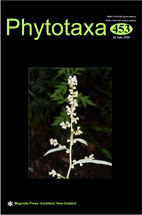Abstract
The Andaman and Nicobar Islands are the largest archipelago system in the Bay of Bengal, consisting of 572 islands and islets. Being situated between two major biodiversity hotspots, namely the Indo-Burma and Sundaland Biodiversity Hotspots, endows it with an unmatched distribution of plants with representatives of the Indian, Myanmar, Malaysian and Indonesian floras (Balakrishnan & Ellis 1996). Nearly 2100 species of angiosperms have been reported from the islands, of which about 11% are strictly endemic (Balakrishnan & Ellis 1996). As these islands are situated in the Equatorial belt and are exposed to marine impacts having a warm and humid tropical climate, the entire area is suitable for growth of orchids. The Andaman and Nicobar Islands harbour about 158 species of orchids, of which 23 species are endemic (Karthigeyan et al. 2014, Singh et al. 2019).
References
Blume, C.L. (1825) Bijdragen tot de flora van Nederlandsch Indië. Ter Lands Drukkerij, Jakarta, 286–354.
<a href="https://doi.org/10.5962/bhl.title.395">https://doi.org/10.5962/bhl.title.395</a>
Gaudichaud, B.C. (1829) Luisia. In: Frecinet, M.L. (Ed.) Voyage autour du monde, entrepris par ordre du roi. Pillet, Paris, p. 426, t.37.
Karthikeyan, K., Jayanthi, J., Sumathi, R. & Jalal, J.S. (2014) A review of the orchid diversity of Andaman & Nicobar Islands, India. Richardiana 15: 9–85.
Kurz, S. (1870) Vegetation of the Andaman Islands. Office of the Superintend of Government Printing, Calcutta, 75 pp.
Lindley, J. (1853) Folia orchidacea. Matthews, London.
Lindley, J. (1830) The genera and species of orchidaceous plants. Ridgways, London, 553 pp.
<a href="https://doi.org/10.5962/bhl.title.499">https://doi.org/10.5962/bhl.title.499</a>
Linnaeus, C. (1753) Species plantarum, vol. 1. Salvius, Stockholm, 560 pp.
Linnaeus, C. (1753) Species plantarum, vol. 2. Salvius, Stockholm, 1200 pp.
Misra S. (2010) A new species of Luisia Gaud. (Orchidaceae) from Andaman and Nicobar Islands, India. Nelumbo 52: 152–155.
Pridgeon, A.M., Cribb P.J., Chase M.W. & Rasmussen F.N. (2014) Genera orchidacearum, volume 6, Epidendroideae vol 3. Oxford University Press, Oxford, 576 pp.
Reichenbach, H.G. (1869) New plants. The Gardeners’ Chronicle 1869: 110.
Reichenbach, H.G. (1863) Ordo XXVIII. Orchides. In: Mueller, C. (Ed.) Annales botanices systematicae (Walper’s), vol. 6, Leipzig, pp. 167–933.
Seidenfaden, G.S. (1971) Notes on the genus Luisia. Dansk Botanisk Arkiv 27: 1–101.
Singh, S.K, Agrawala, D.K., Jalal, J.S., Dash, S.S., Mao, A.A. & Singh P. (2019) Orchids of India-a pictorial guide. Botanical Survey of India, Kolkata, pp. 548.
Smith J.J. (1926–1927) Orchidaceae novae Malayenses XI. Bulletin du Jardin Botanique de Buitenzorg. Buitenzorg 3: 65–66.
Smith, J. (1841) Enumeratio fillicum Philippinarum. In: Hooker, W.J. (Ed.) Journal of botany, vol. 3., Longman, Orme & Co., Edinburgh, pp. 392–422.
Swartz, O. (1799) Dianome epidendri generis Linn. Schrader’s Journal für die Botanik 4: 202–244.
Wallich, N. (1828) A numerical list of dried specimens of plants in the East India. Company’s Museum, London, 306 pp.

